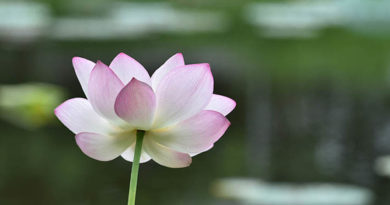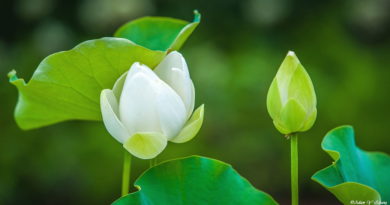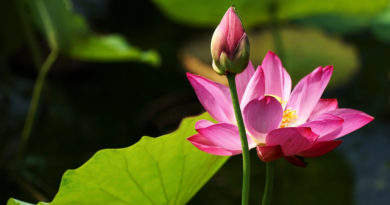ABHIDHAMMA IN DAILY LIFE – CHAPTER 23: LOKUTTARA CITTAS
- The Abhidhamma teaches us about different kinds of wholesome cittas. There are kamavacara kusala cittas (kusala cittas, belonging to the sensuous plane of citta), rupavacara kusala cittas (which are rupa- jhanacittas) and arupavacara kusala cittas (which are arupa-jhanacittas). All these types of citta are kusala but they do not eradicate the latent tendencies of defilements. Only lokuttara kusala cittas (magga-cittas) eradicate the latent tendencies of defilements. When all defilements are eradicated completely there will be an end to the cycle of birth and death.
- Can lokuttara kusala cittas really eradicate defilements so that they never arise again? There are many defilements. We are full of lobha, dosa and moha. We have avarice, jealousy, worry, doubt, conceit and many other kinds of defilements. The clinging to the concept of self is deeply rooted: we take our mind and our body for self. I cannot imagine how all these defilements can be eradicated.
- Defilements can be eradicated and there is a Path leading to it. We have, however, accumulated defilements to such an extent that they cannot be eradicated all at once. Ditthi or wrong view has to be eradicated first; as long as we take realities for self there cannot be eradication of any defilement. There are four stages of enlightenment: the stages of the sotapanna, the sakadaghmi, the anagami and the arahat. Defilements are eradicated stage by stage, until they are all eradicated at the attainment of arahatship. The sotapanna, the ariyan who has attained the first stage of enlightenment, has eradicated ditthi completely.
- When the sotapanna has eradicated ditthi, can it never arise again?
- If ditthi arises again, it means that it has not really been eradicated; in that case that person has not really attained enlightenment and thus he is not a sotapanna. The sotapanna has eradicated all latent tendencies of ditthi, so that it can never arise again.
- How does one know that one has attained enlightenment?
- The lokuttara citta is accompanied by panna (wisdom), which has been developed in vipassana. One does not attain enlightenment without having developed insight-wisdom (vipassana). There are several stages of insight-wisdom. First, doubt about the differences between nama and rupa is eliminated; one realizes when a characteristic of nama presents itself and when a characteristic of rupa presents itself and one is not confused as to their different characteristics. In order to attain even this stage of wisdom, which is only a beginning stage, mindfulness has to be accumulated of the different kinds of nama and rupa which appear in daily life; in this way the panna which knows the characteristics of nama and rupa more clearly can be developed. Later on panna can realize the arising and falling away of nama and rupa, but this stage of wisdom cannot be realized when there is still doubt about the characteristics of nama and rupa. Several more stages of insight-wisdom have to be developed until panna can realize the nama and rupa which appear as impermanent (anicca), dukkha and not-self (anatta), and then enlightenment will be attained. When panna has been developed to this degree, could there be any doubt as to whether one has attained enlightenment or not?
- Can the sotapanna develop vipassana in the wrong way?
- This is ditthi and ditthi has been eradicated by the sotapanna. In the Abhidhamma defilements are classified in different ways and also different kinds of wrong view are classified in various ways. For example, different kinds of wrong view are classified under the group of defilements which is clinging (upadana). Three of the four kinds of clinging mentioned in this group are clinging to different forms of ditthi; these three kinds of clinging are eradicated by the sotapanna. One of them is: ‘clinging to rules and ritual’ (silabbatupadana), which includes the wrong practice of vipassana. Thus, the sotapanna cannot practise vipassana in the wrong way. Some people think that they can attain enlightenment by following some path other than the Eightfold Path.
- Why are there not more ways leading to nibbana?
- The Eightfold Path is developed by being mindful of the nama and rupa which appear at the present moment, such as seeing, visible object, hearing, sound, thinking, or different kinds of feelings. When there is mindfulness of nama and rupa, panna can know their characteristics more clearly and thus wrong view can be eradicated. If the Eightfold Path is not developed, wrong view of realities cannot be eradicated and thus not even the first stage of enlightenment, the stage of the sotapanna, can be attained. Therefore, there is no way leading to nibbana other than the development of right understanding of realities, which is the wisdom (panna) of the Eightfold Path.
- What is right understanding?
- Seeing nama and rupa as they are: impermanent, dukkha and not self. Right understanding can be developed. When we still have wrong view, we take realities for self: we take seeing for self, we take visible object for self, we take feeling for self, we take sanna (‘perception’ or remembrance) for self, we take thinking for self, we also take mindfulness and wisdom for self. In being mindful of the characteristics of nama and rupa when they appear, we will see them as they are; there will be right understanding.
- Could you give an example of wrong practice of vipassana?
- There is wrong practice if, for example, one thinks that in the beginning, one should be aware only of certain kinds of nama and rupa, instead of being aware of whatever kind of nama or rupa appears. There is wrong practice if one thinks that there should not be mindfulness of the characteristics of lobha, dosa and moha when they appear. Then one selects the nama and rupa one wants to be aware of and the wrong view of self cannot be eradicated. Another example of wrong practice is thinking that vipassana can only be developed when sitting. In that way one sets rules for the practice, one thinks that one can control awareness. Thus one cannot see that mindfulness too is anatta (not self).
- What other defilements has the sotapanna eradicated?
- The sotapanna has eradicated doubt or vicikiccha. Doubt is classified as one of the ‘hindrances’: it prevents us from performing kusala. We may doubt about the Buddha, the Dhamma, the Sangha, about the right practice. The sotapanna has no more vicikiccha.
Another akusala cetasika, eradicated by the sotapanna, is macchariva or stinginess. The ‘Visuddhimagga’ (XXII, 52) mentions five kinds of avarice:
The kinds of avarice are the five, namely, avarice about dwellings, families, gain, Dhamma and praise, which occur as inability to bear sharing with others any of these things beginning with dwellings.
The ‘Atthasalini’ (Expositor, Book II, part II, Ch. II, 374, 375) gives an explanation of these five kinds of stinginess concerning the monk’s dwelling-place, the family he is used to visit in order to receive the four requisites (robes, food, shelter, medicine), the four requisites themselves (mentioned as ‘gain’), knowledge of the Dhamma and praise (concerning personal beauty or virtues).
It is explained that there is stinginess if one does not want to share any of these things with others. However, there is no stinginess if one does not want to share these things with someone who is a bad person or someone who would abuse any of these things. For instance, if one does not teach Dhamma to someone who will abuse Dhamma, there is no stinginess as to Dhamma. Thus we see that the eradication of macchariya does not mean sharing everything one has with anybody. The sotapanna has eradicated macchariya; the five kinds of stinginess just mentioned do not arise.
Furthermore, the sotapanna has eradicated issa or envy, lssa can arise with a dosa-mula-citta (citta rooted in aversion). The ‘Visuddhimagga’ (XIV, 172) states concerning envy:
Envying is envy. It has the characteristic of being jealous of other’s success. Its function is to be dissatisfied with that. It is manifested as averseness from that. It proximate cause is another’s success…
- It is so human to be jealous. I heard that some psychiatrists are founding an institute where they will train people not to be jealous.
- Psychiatrists may try to cure people of jealousy, but how could they eradicate the tendencies of jealousy in the citta of others? Only the wisdom which is developed to the degree of the sotapanna can eradicate jealousy completely, so that it never arises again.
- It is marvelous that such ugly things as stinginess and jealousy can be eradicated. It is right to call the sotapanna an ariyan (‘noble one’), although not all defilements are eradicated by him.
- The sotapanna is an ariyan because at the moment of enlightenment the sotapanna has become a different person; he is no longer a ‘worldling’ (puthujjana). There is no more latent tendency of ditthi accumulated in the citta, nor are there latent tendencies of vicikiccha (doubt), macchariya (stinginess) or issa (envy) either.
- What is exactly a latent tendency?
- When you desire something you have lobha. When the lobha-mula-cittas have fallen away, there are other kinds of citta which are not accompanied by lobha. However, the lobha which arose before has been accumulated, it is latent. When there are conditions, it can arise again with the akusala citta. Latent tendencies are accumulated in every citta, even in the bhavanga-citta (life-continuum) which does not experience an object through one of the sense-doors or through the mind door.
- Is ditthi eradicated gradually or suddenly?
- One cannot attain enlightenment without having cultivated the right conditions. We see that in the Buddha’s time some people could attain enlightenment quickly, even during a discourse; some could attain enlightenment after a more detailed explanation of the truth, while others had to develop the Eightfold Path for a longer time, sometimes for many years, before they could attain enlightenment. It all depends on how much wisdom has already been accumulated, including accumulation from previous lives. As to who can attain enlightenment in the present time, the right conditions have to be cultivated; enlightenment cannot occur quickly. There should be awareness of all kinds of nama and rupa appearing in our daily life and panna has to consider their characteristics over and over again. In this way panna can gradually develop. We cannot expect a great deal of sati and panna in the beginning. However, each moment of right awareness is fruitful, because it can
condition further moments of awareness and thus it can be accumulated. When panna realizes a phenomenon which appears are nama or rupa, there is less clinging to the concept of self and in this way ditthi is gradually eradicated, until finally all latent tendencies of ditthi are eradicated by the magga-citta (lokuttara kusala citta) of the sotapanna; then ditthi will never arise again. - Can the sotapanna still talk in an unpleasant way to others?
- Of the ten kinds of akusala kamma-patha there are four akusala kamma-patha through speech which are: lying, slandering, rude speech and useless talk. The sotapanna has eradicated lying. He can still say unpleasant things about others or use harsh speech, but not to the extent that it would lead to rebirth in a woeful plane. The sotapanna cannot be reborn in a woeful plane any more. Useless talk, which is talk not connected with dana, sila or bhavana, is not eradicated by the sotapanna; it can only be eradicated by the arahat.
- Why is it necessary to classify defilements in such a detailed way?
- Learning about the different ways of classifying defilements helps us to see their different aspects. For instance, ditthi is classified under the group of defilements known as the latent tendencies or proclivities (anusayas) and it is also classified as one of the ‘asavas’ or ‘influxes’, which is another group of defilements. Furthermore, defilements are classified as ways of clinging (upadanas); as we have seen, three classes of ditthi are classified under this group of defilements. Defilements are also classified as ‘bonds’ (ganthas), as ‘hindrances’ (nivaranas), and in several other ways. Each way of classifying shows us a different aspect of defilements and thus we understand better how deeply accumulated defilements are and how difficult it is to eradicate them. Only magga-cittas (lokuttara kusala cittas) can eradicate them. Not all defilements can be eradicated by the magga-citta of the first stage of enlightenment.
- How many types of lokuttara citta are there in all?
- There are eight types of lokuttara citta. There are four types of magga-citta, because there is a magga-citta for each of the four stages of enlightenment (the stages of the sotapanna, the sakadagami, the anagami and the arahat). There are four types of phala-citta (phala means fruit) which are the four results of the four magga-cittas (lokuttara kusala cittas). Only the magga-citta eradicates defilements; the phala-citta is vipaka, result of the magga-citta.
- Is a great deal of study necessary if one wants to develop vipassana? It seems that we have to learn endless classifications and distinctions, groups and sub-groups.
- The purpose of the study of the Abhidhamma is right understanding of realities, If one does not study at all one will not be able to judge what is the right Path and what is the wrong Path. It depends on one’s own inclination how much one will study. We do not live in the Buddha’s time and since we therefore cannot hear the teachings directly from him, we are dependent on the teachings as they come to us through the scriptures.
- What is exactly nibbana? Is it a plane of life?
- If nibbana were another plane of exsitence in which we could continue to live, it would mean that there would continue to be for us nama and rupa arising and falling away. Life is nama and rupa arising and falling away. Our life is dukkha, because what arises and falls away is unsatisfactory; it is dukkha. Nibbana, however, is the unconditioned dhamma, it does not arise and fall away. Nibbana is therefore the end of dukkha. When one has attained enlightenment, even if it is only first stage of enlightenment, it is certain that there will eventually be an end to birth, old age, sickness and death, and thus, an end to dukkha. When the person who is not an arahat dies, the last citta of his life, the cuti-citta death-consciousness) is succeeded by the patisandhi-citta (rebirth-consciousness) of the next life and thus life goes on and on. As long as there are defilements life has to continue. The fact that we are here in the human plane is conditioned by defilements. Even if there is birth in a heavenly plane, in a rupa-brahma plane or in an arupa-brahma plane, it is conditioned by defilements. The arahat has no more defilements, he does not have to be reborn in any plane; for him there will not be, after the cuti-citta, the arising of nama and rupa any more. The arahat has to die, because he was born and birth has to be followed by death. Since his death-consciousness, however, is not succeeded by rebirth-consciousness, it is for him the end of the cycle of birth and death
- It seems to me that nibbana is something negative, it is the annihilation of life.
- Nibbana is the destruction of lobha, dosa and moha. Is that not something positive?
- I agree that the eradication of defilements is probably the highest attainable goal in one’s life. But is no more rebirth not sorrowful?
- It depends on the way you see life. As we have seen, life is nama-elements and rupa-elements which arise and fall away. Can nama and rupa which arise and fall away be true happiness?
- I think that life can give us much joy, in spite of dark moments.
- True, there are moments of what we call happiness, but these moments arise and fall away, they are extremely short. We can make ourselves believe that life is good and that it should continue, or, we can search for the truth in order to see things as they are. It depends on what we really want in life: to be ignorant or to know the truth. If we develop insight we will see more and more the impermanence and the unsatisfactoriness of life. Then the ideas we used to have about life and happiness will be changed. The ariyan knows that what the non-ariyan takes for happiness is dukkha; the non-ariyan takes for misery what the ariyan knows is happiness. The development of wisdom brings a kind of happiness which is different from what one used to take for happiness.
- I do not like the idea of extinction of life.
- If one still clings to the ‘self’ one is anxious about what will happen to the ‘self after one’s death. For the arahat the question does not occur what will happen after his death; he has no more defilements and thus he has no more clinging to life. People who are not ariyans cannot understand yet what nibbana is. If we cannot experience yet the true nature of the dhammas which arise and fall away, we cannot experience the dhamma which does not arise and fall away, the unconditioned dhamma.
- Each citta experiences an object. What is the object experienced by the lokuttara citta?
- The lokuttara citta experiences the dhamma which does not arise and fall away, it experiences nibbana. As we have seen, there are four paramattha dhammas: citta, cetasika, rupa and nibbana. Citta, cetasika and rupa are realities which arise and fall away, they are conditioned dhammas (sankhara dhammas). Nibbana does not arise and fall away. It has no conditions through which it arises, it is an unconditioned dhamma (visankhara dhamma). We cannot experience the unconditioned reality unless panna is developed to the degree that it can experience the conditioned dhammas as they are: impermanent, dukkha and anatta (not self).
- Do both magga-citta and phala-citta directly experience nibbana?
- The magga-citta and the phala-citta are lokuttara cittas, thus they have nibbana as the object. When the magga-citta has fallen away, it is succeeded immediately by the phala-cittas which experience the same object. When one performs kimavacara kusala kamma (kusala kamma of the sensuous plane of consciousness) the vipaka does not follow immediately. Even if the vipaka were to arise soon after the kamma, it could never arise in the same process of citta( When one attains jhana, the vipaka, if it arises, only arises in a next life.). It is different with the lokuttara citta. The magga-citta has to be followed immediately by the phala-cittas, which are two or three moments of citta, depending on the individual.
- When the sotapanna attains enlightenment there are the magga-citta of the sotapanna and the phala-cittas of the sotapanna. How often during a lifetime can these cittas arise again?
- The magga-citta of the sotapanna can arise only once in the cycle of birth and death, because its function is to eradicate defilements: When the defilements which are to be eradicated at the stage of the sotapanna have been eradicated, it is once and for all. Thus, the magga-citta of that stage does not arise again.
The phala-citta can arise again in other processes of citta if enlightenment is attained with absorption. As we have seen (Ch. 22), lokuttara cittas accompanied by jhana-factors can experience nibbana with absorption in the case of those who have accumulated skill for jhana. Those who attain enlightenment have different accumulations and according to one’s accumulations the lokuttara cittas are accompanied by jhana-factors of different stages of jhana. The phala-citta which is accompanied by jhana-factors can arise many times again, experiencing nibbana with absorption.
Cittas can be counted as eighty-nine or as a hundred and twenty-one- When cittas are counted as a hundred and twenty-one, there are, instead of eight lokuttara cittas, forty lokuttara cittas, which are lokuttara cittas accompanied by jhana-factors. As we have seen, there are five stages of rupa-jhana and at each stage jhana-factors are successively abandoned (See Ch. 22), until at the fifth stage (or at the fourth stage of the fourfold system) there are the remaining factors of samadhi (concentration) and upekkha (indifferent feeling), which arises instead of sukha (pleasant feeling). Lokuttara cittas can be accompanied by jhana-factors of each of the five stages of jhana. For example, when lokuttara cittas are accompanied by jhana-factors of the fifth stage of rupa-jhana, it means that they are accompanied by samadhi and upekkha.
As regards the arupa-jhanacittas, they have meditation subjects which are different from rupa-jhana, but the jhana-factors which accompany them are the same as the jhana-factors of the fifth stage of rupa-jhana, namely samadhi and upekkha. Thus, the jhana-factors of only five types of jhanacitta have to be taken into account when we classify lokuttara cittas which are accompanied by jhana-factors. Consequently, each one of the eight lokuttara cittas can be resolved into five classes and then they can be counted as forty lokuttara cittas
When cittas are counted as 89, they can be summarized as follows:.
12 akusala cittas
18 ahetuka cittas
8 maha-kusala cittas } 54 kamavacara cittas (cittas of the sensuous
8 maha-vipaka cittas plane of consciousness)
8 maha-kiriyacittas
15 rupavacara cittas
12 arupavacara cittas
8 lokuttara cittas
When cittas are counted as 121, there are, instead of 8 lokuttara cittas, 40 lokuttara cittas.
- It seems to me that the way to nibbana is a long way. How could we ever attain it?
- We should not be impatient and wish for a result that is far off. Instead, we should consider what we have to do at the present moment: to develop mindfulness of the nama and rupa which appear right now. Thus we cultivate the condition for the attainment of nibbana.
Source: Budsas.net







